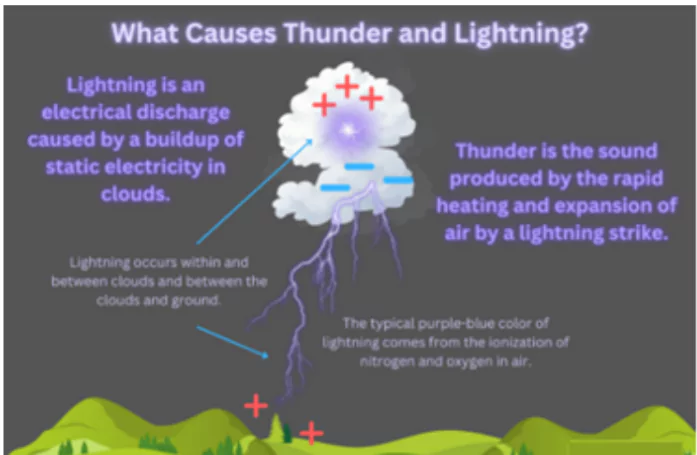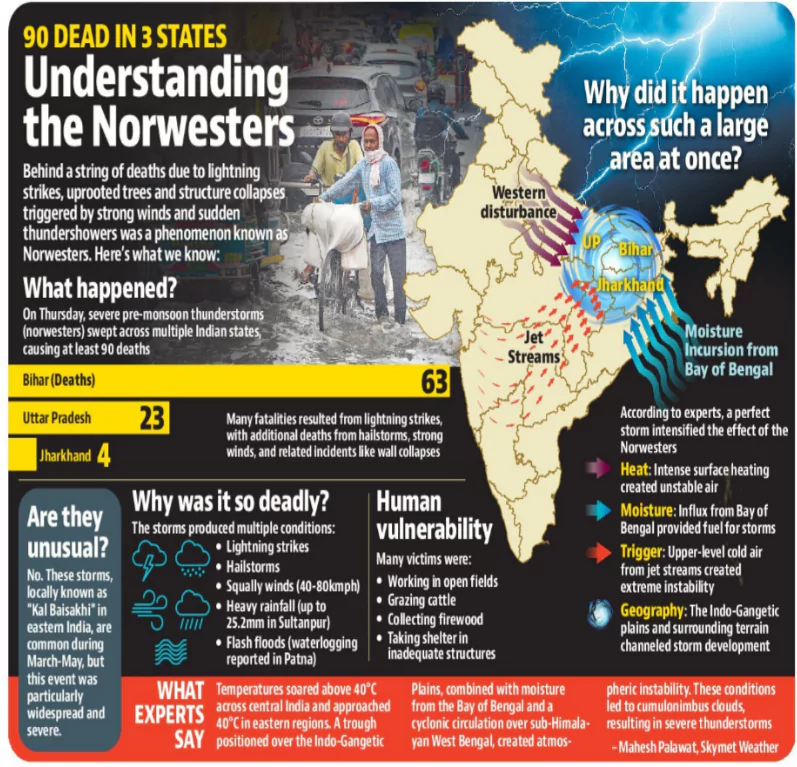80 people were killed in 72 hours due to thunderstorms and lightning across Bihar.
- Recurring Pattern: Bihar has witnessed a recurring pattern of deadly natural disasters, with over 90 deaths in a similar event in June 2020.
- Pre Monsoon Occurrence: In regions like Bihar, thunderstorms are common during the pre-monsoon and early monsoon months (April to June) and can be especially deadly when accompanied by lightning and squall winds.
- National Crime Records Bureau Data: Bihar ranks second in the country in terms of lightning-related fatalities, with the National Crime Records Bureau reporting that lightning accounts for nearly 39% of deaths from natural disasters across India.
- On average, the state records around 250 natural disaster-related deaths each year.
About Lightning

- Lightning is a natural electrical discharge during storms, occurring when charged particles in the atmosphere build up and release energy.
- This release produces a flash of light (lightning) and the associated thunder caused by rapidly expanding air.
- Formation: Lightning forms when positively and negatively charged particles in the atmosphere or within clouds create an imbalance.
- When the difference is large enough, a discharge occurs.
- Types: The most common types are cloud-to-ground, cloud-to-cloud, and intra-cloud lightning.
 Impact: Lightning can cause fires, power outages, structural damage, and fatalities, especially in lightning-prone areas.
Impact: Lightning can cause fires, power outages, structural damage, and fatalities, especially in lightning-prone areas.- Centre Government’s View About Lightning: Lightning not classified as a natural disaster.
Factors Contributing to Bihar’s High Vulnerability to Lightning
- Climate and Terrain: Bihar’s humid subtropical climate, marked by high temperatures and monsoonal rains, promotes thundercloud formation.
- Its flat plains and proximity to the Himalayas amplify storm activity, as cold mountain winds collide with warm, moist air from the lowlands.
- Moisture influx from the east is intensifying lightning activity.
- Rural Exposure: With a largely rural population dependent on agriculture, many people are exposed while working in open fields during storms.
- Lack of Protection: Villages often lack tall buildings, lightning rods, or sufficient shelter, increasing vulnerability.
- Low Awareness: Villagers often ignore official warnings despite large-scale alert systems (12 crore SMS alerts sent).
- Moist Soil and Water Bodies: The abundance of rivers and wetlands keeps Bihar’s soil moist, which boosts electrical conductivity and the chances of ground strikes during lightning events.
- Impact of Climate Change: Shifting weather patterns, rising temperatures, and erratic wind flows have contributed to a rise in severe weather incidents, including lightning strikes.
National Disaster Management Authority (NDMA) Guidelines: Key Points
- Early Warning Systems: NDMA emphasizes timely, accurate early warnings in local languages through multiple platforms such as TV, radio, SMS, and mobile apps.
- Communication of Do’s & Don’ts: Clear, simple, and accessible instructions are to be disseminated to the public for each disaster type.
- Hazard Mapping & Prevention: NDMA recommends detailed hazard vulnerability mapping and early preventive actions to reduce disaster risks.
- Disaster-Resilient Infrastructure: It encourages adoption of resilient building codes and infrastructure planning, especially in high-risk areas.
- Underground Cabling: In dense urban and vulnerable areas, underground electrical and communication cables are advised to reduce exposure.
- Community Disaster Management: Formation and training of community-level disaster management groups are vital for decentralized response.
- Emergency Preparedness in Hospitals: Hospitals must be equipped with emergency kits, SOPs, and designated triage areas to handle mass casualties.
|
Steps Taken to Prevent Lightning-Related Deaths in India
- Early Warning System: India has developed an advanced lightning early warning system.
- Forecasts are available 3 hours to 5 days in advance, enabling timely alerts.
- India is among the only five countries globally with such capability.
- LIghtning Location Networks: Indian Institute of Tropical Meteorology (IITM), Pune has established a lightning location network strategically installed at 83 places in the country to detect and locate lightning strikes with utmost accuracy.
- Damini App: The Damini app provides real-time lightning alerts based on GPS and user location.
- It warns users when lightning is within 20–40 km of their location.
- It also offers 40-minute advance warnings, along with safety instructions for lightning-prone areas.
- State Lightning Action Plans: States are being encouraged to formulate and implement Lightning Action Plans similar to heat action plans.
- Lightning Resilient India Campaign: is a community-centric outreach programme launched by the Climate Resilient Observing-Systems Promotion Council (CROPC).
- It is supported by key stakeholders like National Disaster Management Authority (NDMA), India Meteorological Department (IMD), the Ministry of Earth Sciences, and the Indian Meteorological Society.
- Public Awareness and Education: The National Disaster Management Authority (NDMA) runs campaigns through TV (Doordarshan) and Radio (All India Radio) for awareness generation among masses on ‘Thunderstorm & Lightning’.
- Example: Simple behavioural changes, like avoiding open fields during storms, are encouraged.
Way Forward
- Official Recognition as a Natural Disaster: Classifying lightning as a natural disaster under the Disaster Management Act, 2005 can ensure better funding, preparedness, and response mechanisms.
- Strengthen last-mile communication: by leveraging local governance bodies, panchayats, and community networks so that farmers, fishermen, outdoor workers etc are able to act on alerts.
- Lightning Atlas & Hotspot Mapping: Developing a Lightning Atlas with hotspot mapping will help identify high-risk areas, enabling targeted awareness programs, better resource allocation, and infrastructure resilience
Conclusion
Strengthening awareness campaigns, resilient infrastructure, and real-time localized alerts is critical to saving lives. While lightning events may reduce post-monsoon, proactive long-term planning remains essential in a changing climate.
![]() 12 Apr 2025
12 Apr 2025


 Impact: Lightning can cause fires, power outages, structural damage, and fatalities, especially in lightning-prone areas.
Impact: Lightning can cause fires, power outages, structural damage, and fatalities, especially in lightning-prone areas.